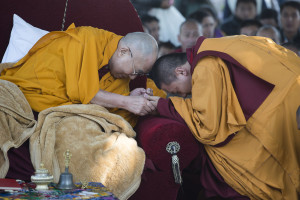His Holiness arrives in Sankisa
[dalailama.com] Sankisa, UP, India 30 January 2015: His Holiness the Dalai Lama arrived in Sankisa this morning after a short flight from Delhi to Farrukhabad airport, where he was received by Mr Alok Kumar Shakya, UP State Minister for Technical Education. Under clear blue skies a cool breeze stirred the fresh air as the sun shone bright and warm. His Holiness came directly to the sacred site, marked by the remains of the elephant capital of the Ashokan pillar, which now stands under a canopy near a hillock that is regarded as the ruins of a stupa.

His Holiness was welcomed to Sankisa by Mr Suresh Chandra Bauddha, President of Young Buddhists Society (YBS) India, Mr Alok Kumar Shakya, the DC and SP of Farrukhabad District and members of the organizing committee. Greeting friends in the orderly crowd His Holiness walked to the foot of the stupa and made three prostrations before taking his seat in a large armchair.
Accompanied by monks from Namgyal Monastery he immediately began to recite prayers and praises to the Buddha that included the ‘Heart Sutra’, Salutations from ‘Ornament for Clear Realization’ and ‘Fundamental Wisdom’, the Cloud of Offerings dharani, the Samantabhadra Prayer, Je Tsongkhapa’s Praise to the Buddha for Teaching Dependent Arising, the Praise to the Seventeen Masters of Nalanda, and the Essence of Dependent Arising dharani, Verses of Auspiciousness Related to the Three Jewels and the ‘Sage’s Harmonious Song of Truth’, a Prayer for the Inclusive Flourishing of the Teachings of the Buddha. At the conclusion of the prayers the offered fruit and sweetmeats were distributed among the crowd.
Sankisa, historically known as Sankasya, is the most westerly of the eight principal places of Buddhist pilgrimage. However, it is one of the four unchanging sacred sites which include Bodhgaya, where all the Buddhas will attain enlightenment, Sarnath, where they will all begin their teachings, Shravasti, where they will all extend the teaching and defeat doctrinal opponents. Sankisa is where all the Buddhas descend to earth after spending the Rainy Season Retreat in the Heaven of Thirty-Three teaching their mothers who are reborn there.

It is said that seven days before his descent to earth the Buddha set aside his invisibility. Anuraddha perceived him by his divine sight and urged Maudgalyayana to go and greet him. The great disciple did so, telling the Buddha that the Sangha longed to see him. Shakyamuni replied that in seven days he would return to the world. A great assembly of the kings and people of the eight kingdoms gathered. As the Buddha descended, a flight of gold stairs appeared, down which he came. He was accompanied on the right by Brahma, who, holding a white chowry, descended on a crystal staircase, while to the left Indra came down a flight of silver stairs, holding a jewelled umbrella. A great host of gods followed.
It is reported that the three flights of stairs disappeared into the ground, but for seven steps of each, which remained visible. When the Emperor Ashoka came here two centuries later he had men dig into the earth around the protrusions in order to discover their depth. Although they reached the level of water, they could not find the stairs’ end. With increased faith, Ashoka then built a temple over them with a standing image of the Buddha above the middle flight. Behind this temple he erected a great pillar surmounted by an elephant capital. Today, the elephant capital is still here.
In the early fifth century CE, the Chinese pilgrim Fa Hsien walked from China to India in search of Buddhist books on discipline, the Vinaya. He was followed two centuries later by Hsuan Tshang. Records of the travels of both, which contain detailed accounts of the holy places they visited, have survived in Chinese and were translated into English in the 19th century.
Because the elephant’s tail and trunk had been destroyed, both Chinese pilgrims mistook the capital in Sankisa for a lion. Hsuan Tshang writes of a monastery, which he describes as excellently ornamented and having many fine images. He further says that some hundreds of monks dwelt there and that the community had lay followers. Two centuries earlier Fa Hsien found roughly 1,000 monks and nuns living here pursuing their studies, some of the Hinayana and some of the Mahayana.
Both pilgrims tell stories of a Naga, which they refer to as a dragon, that acted as a patron of this community of monks and nuns, causing abundant harvests and enriching rains to come in season, without calamity, so the community were able to live at ease. Fa Hsien remarked that the country was productive and the people were prosperous and happy. He noted that they were particularly hospitable and welcoming to visitors from elsewhere.
Like many of the Buddhist pilgrimage places in India, Sankisa fell into decline and was all but forgotten. General Alexander Cunningham the distinguished British archaeologist identified the site in 1862. The elephant capital was set right again and a canopy erected over it, but little excavation or archaeological investigation seems to have been done. Anagarika Dharmapala the great Sinhalese Buddhist activist visited the site in 1930s and is said to have been responsible for a small stupa shaped temple near the elephant capital.
His Holiness the Dalai Lama first visited Sankisa 55 years ago barely nine months after coming into exile in India. A prominent local family retain photographs of the occasion and a letter he wrote at the time. In it he noted that Sankisa was the location of an event, the Buddha’s descent from Tushita, that Tibetans celebrate on 22nd of the ninth month every year. He added:
“All of us who revere this site where the Buddha walked have a duty to pay great attention to his teachings. I urge all to be devoted to wholesome acts and avoid misdeeds.”
Tomorrow, His Holiness will begin to teach from the Dhammapada.

